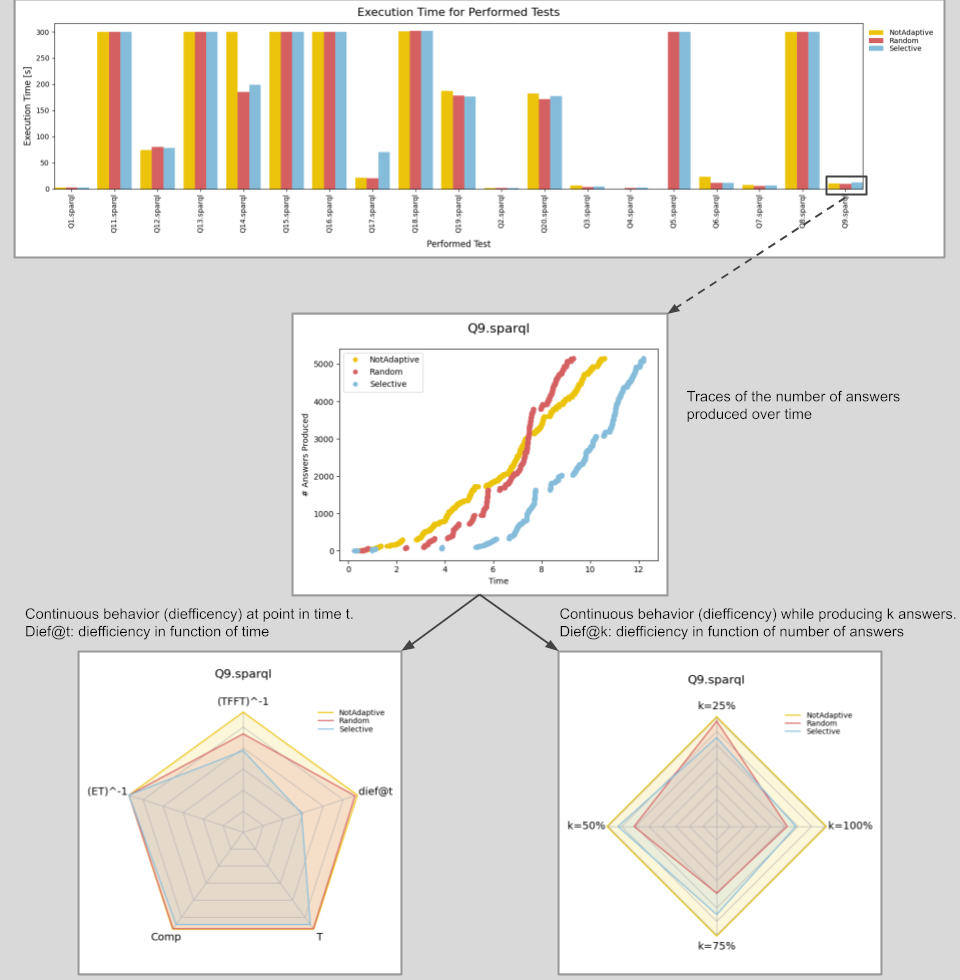Python package for computing diefficiency metrics dief@t and dief@k.
Project description
Philipp D. Rohde, Nikoleta Themeliotou
diefpy
Python package for computing diefficiency metrics dief@t and dief@k.
The metrics dief@t and dief@k allow for measuring the diefficiency during an elapsed time period t or while k answers are produced, respectively. dief@t and dief@k rely on the computation of the area under the curve (AUC) of answer traces, and thus capturing the answer rate concentration over a time interval.
This fork of the original diefpy repo by Maribel Acosta provides a complete Python3 version.
Description

Fig. 1 gives an overview of the result plots that can be produced using the package. Firstly, the overall Execution Time for all the tests and approaches (NotAdaptive, Random and Selective) in the metrics data can be created as a bar plot. For evaluating the input tests an answer trace of each approach (NotAdaptive, Random and Selective) can be created which shows how many answers were produced. Finally, two Radar Plots can be created. The Radar Plot on the left compares dief@t with other benchmark metrics in a specific test. The other benchmark metrics being conventional metrics like total execution time, time for the first tuple, throughput, and number of answers produced. The Radar Plot on the right compares dief@k at different answer completeness percentages in a specific test by measuring the continuous efficiency of approaches when producing the first 25%, 50%, 75%, and 100% of the answers.
Installation
You can build and install diefpy from source
git clone git@github.com:SDM-TIB/diefpy.git
cd diefpy
python -m pip install -e .
or downloading it from PyPI:
python -m pip install diefpy
Notice: Most likely you want to install diefpy into a virtual environment for the experiments you were running.
Usage
We refer the user to the documentation of the library for a detailed explanation of the implemented functionality.
The page also includes some examples.
Additionally, there is an iPython notebook in the example folder that demonstrates the use of the diefpy library.
Publications
[1] Maribel Acosta, Maria-Esther Vidal, York Sure-Vetter. Diefficiency Metrics: Measuring the Continuous Efficiency of Query Processing Approaches. In Proceedings of the International Semantic Web Conference, 2017. Nominated to Best Paper Award at the Resource Track. https://doi.org/10.1007/978-3-319-68204-4_1
[2] Maribel Acosta, Maria-Esther Vidal. Measuring the Performance of Continuous Query Processing Approaches with dief@t and dief@k. In the International Semantic Web Conference, Posters and Demos, 2017. online
Project details
Release history Release notifications | RSS feed
Download files
Download the file for your platform. If you're not sure which to choose, learn more about installing packages.
Source Distribution
Built Distribution
File details
Details for the file diefpy-1.2.1.tar.gz.
File metadata
- Download URL: diefpy-1.2.1.tar.gz
- Upload date:
- Size: 149.3 kB
- Tags: Source
- Uploaded using Trusted Publishing? No
- Uploaded via: twine/4.0.2 CPython/3.9.17
File hashes
| Algorithm | Hash digest | |
|---|---|---|
| SHA256 |
667e977d964cfb46eaada7121b32cb82b51f53cb4139917dea26eb94f07c2d17
|
|
| MD5 |
fcd5e2b7fdd7bba65a5da5a9de65b792
|
|
| BLAKE2b-256 |
adbfbc4a00dc161f82ad25700beb7dcb3f3ba4496fb3d5fd4f509691d3423520
|
File details
Details for the file diefpy-1.2.1-py3-none-any.whl.
File metadata
- Download URL: diefpy-1.2.1-py3-none-any.whl
- Upload date:
- Size: 149.0 kB
- Tags: Python 3
- Uploaded using Trusted Publishing? No
- Uploaded via: twine/4.0.2 CPython/3.9.17
File hashes
| Algorithm | Hash digest | |
|---|---|---|
| SHA256 |
1a6879171366733c1b23d9adf19e0f7ebe9b7a07417e1a37cdb5210614c3bd8a
|
|
| MD5 |
7cb79d9ebce42e57ab127daa66925a1b
|
|
| BLAKE2b-256 |
b0cff28f70e46dea3a69a5d3ff46304b2ac8c2f144d394db8b25ac4d354c74a4
|


















